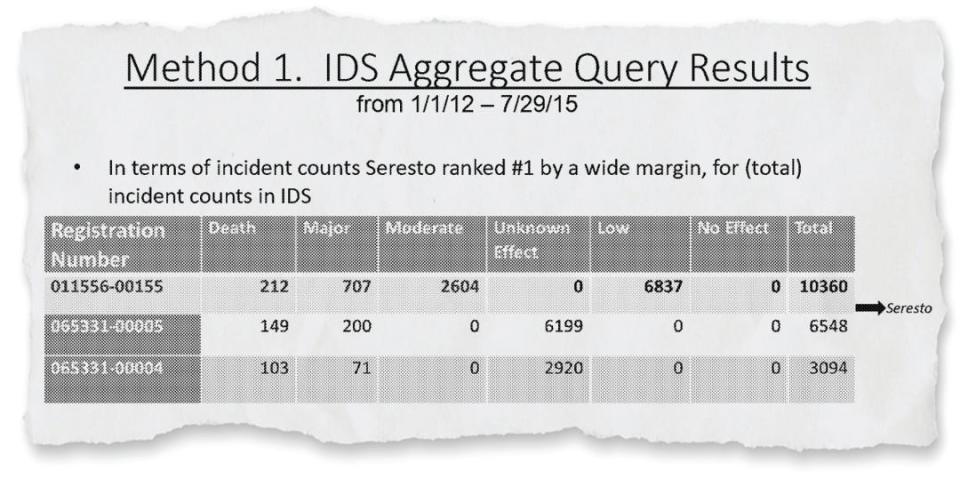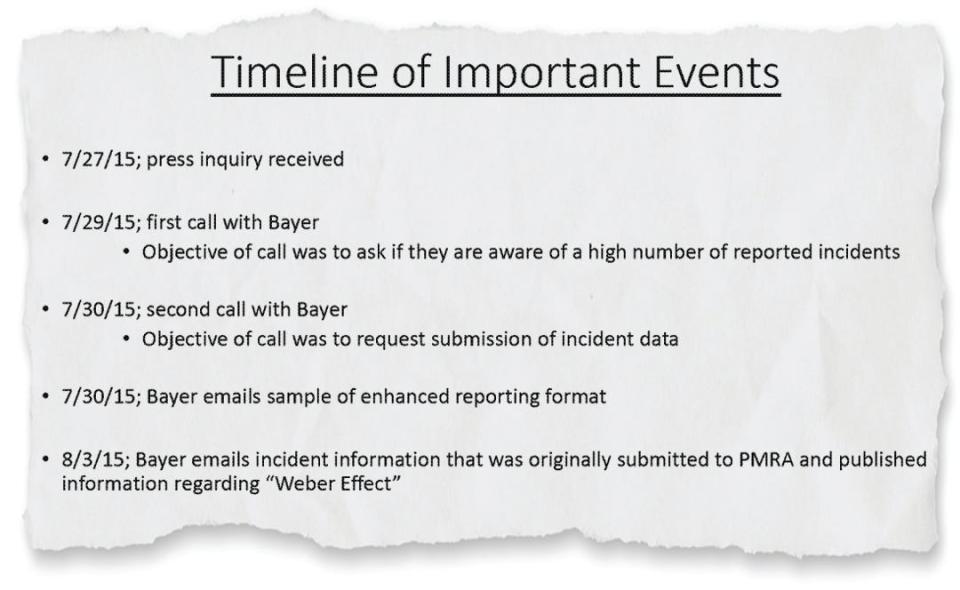Slammed for lax oversight of flea collars blamed for pet deaths, EPA seeks to hand off regulation to FDA
The U.S. Environmental Protection Agency wants to relinquish its oversight of pet pesticide products in the wake of criticism for its handling of a popular flea and tick collar linked to more than 100,000 reports of pet injuries and deaths.
Its bid to hand the job to the Food and Drug Administration caps a tumultuous period for the EPA triggered by a March 2021 Investigate Midwest/USA TODAY investigation that showed the collar has been the subject of more incident reports than any other product in EPA history.
For years, EPA scientists have questioned the agency’s ability to regulate pet products because of how it has handled complaints about Seresto since it came on the market in 2012, according to Investigate Midwest/USA TODAY reporting. The EPA said Seresto is a “key part” but not all of the reason for the proposal.
Transferring regulation to FDA is a “potential long-term solution,” said Jake Li, EPA’s deputy assistant administrator for pesticide programs, in an interview with Investigate Midwest.
“We can't play this whack-a-mole game where every time a Seresto-like incident comes up, we have to divert our staff to it,” Li said.
Investigation: Popular flea collar linked to almost 1,700 pet deaths. The EPA has issued no warning.

The EPA has been conducting a formal review of Seresto for nearly two years and expects to finalize the updated science assessment “in the next few months, Li said, adding that the FDA helped with the assessment, both by lending staff and a framework to evaluate post-market incident data.
The work on Seresto illustrated the flaws with EPA’s process, Li said.
“In our ongoing review of Seresto incidents what really became evident to us is that, compared to FDA, we at EPA have far fewer resources, which means staff, expertise, infrastructure and funding, to evaluate animal safety and carry out the ongoing monitoring of products in the marketplace,” Li said.
Li said the EPA’s pesticide office has only two veterinarians on staff, and both were pulled from their regular duties to work on a review of Seresto “almost full time,” which slowed down their other jobs.
The Seresto review “has poached so much time out of people who are not assigned to any of this work that we believe there needs to be a much better solution for the long term,” Li said.
The agencies said in a joint whitepaper that FDA would need “significant new resources” to take over the management of the 600 topical products currently regulated by the EPA; however, the agencies said building a comparable program at EPA also would require even more resources and would be redundant with the FDA’s system.
FDA spokeswoman Veronika Pfaeffle said in an emailed statement that the current set-up doesn’t accommodate scientific advancement.
“A modernized approach that better aligns with each agency’s expertise will better protect animal health and safety and improve clarity for pet owners,” Pfaeffle said in the email.

‘FDA should be the one-stop-shop’
Under the current setup, the EPA is responsible for regulating pet pesticide products that are “not systemic,” or aren’t supposed to enter the bloodstream, while the FDA regulates “systemic” pet pesticide products, which are generally consumed by pets.
However, the agencies said in the recent whitepaper that scientists now understand that many topical flea and tick treatments, including spot-on treatments and collars, actually do enter a pet’s bloodstream, raising questions about the EPA’s product approval process.
“Both agencies agree that FDA should be the one-stop-shop for animal drugs, for these external parasite treatments and so forth,” Li said.
The EPA and FDA are holding a joint virtual public meeting, titled “Modernizing the Approach to the EPA and FDA Oversight of Certain Products,” on March 22 at 1 p.m. EDT to discuss the changes. People can register for the meeting here. The proposal is also open for a 60-day public comment period until April 24.
“Moving this forward is a good thing, but it will take years to do. This is the beginning of a very, very long process,” said Nathan Donley, environmental health science director of the Center for Biological Diversity, which petitioned to ban Seresto.
Donley expressed concern the EPA is allowing harm to continue by failing to take action on products like Seresto.
“It doesn't let the EPA off the hook,” Donley said. “They’ve got to do things now that are in their authority.”
Seresto is just one product connected to major concerns about pet and human safety. In October 2022, the EPA announced it would ban flea and tick collars containing the chemical tetrachlorvinphos, which has been linked to neurological damage in children.
EPA staff have also raised concerns in internal documents about pet products that contain fipronil, a chemical used in popular spot-on treatment Frontline Plus, which has been the subject of more than 5,000 human health incident reports, according to an Investigate Midwest review of incident data.
Review in the works for ‘years’
EPA staff sounded alarms about the safety of Seresto as early as 2015. But the agency did not launch a formal review until after the nonprofit Center for Biological Diversity filed a petition asking the agency to cancel Seresto, following Investigate Midwest's and USA TODAY’s reporting.
Last summer, a congressional subcommittee called on the EPA to cancel Seresto’s registration, noting that Canada had rejected the collar based on the EPA’s own incident data – and the EPA found an even greater link between pet death and the collar than Canadian regulators did.

More: Congressional subcommittee seeks voluntarily recall of Seresto flea and tick collar
For years, EPA and officials from Bayer and Elanco, which purchased the animal health division of Bayer – including Seresto – in 2020, met to discuss the agency’s issues with the product. In those meetings, company officials blamed other factors, including the high number of Seresto collars sold.
Elanco maintains the collar is safe based on internal studies. A company-funded analysis found that the two chemicals in Seresto – imidacloprid and flumethrin – have not been responsible for any pet deaths.
EPA scientists did multiple comparisons over the years between Seresto and other products that indicated Seresto had a higher number of pet deaths than other products, documents show. Those scientists often emailed that information, until a superior told two scientists to keep their concerns off email.
Yet the EPA did not make the public aware of any risks. The EPA’s inspector general has launched a review into the agency’s handling of incident reports associated with the product.
Li said the proposal to transfer pet-pesticide product regulation to the FDA was in the works since before the public outcry over Seresto.
“Seresto is a key part of that, but it's not the only part,” Li said. “It predates Seresto by three to four years. It's really driven by the discussion between our career staff and the FDA’s career staff.”

In a March 2021 presentation made in response to the Investigate Midwest/USA TODAY story about Seresto, EPA staff pointed out that compared to the FDA, the agency’s process is lacking. The presentation noted the EPA’s process relies on company-funded studies that use less sensitive pet breeds and small sample sizes. By comparison, the FDA has a much more comprehensive pet product regulation process, which includes pre-market clinical trials and post-market surveillance.
The EPA also has no process for evaluating pet incident reports or any trigger for when incident numbers need further review.
Documents show that EPA officials briefed Ed Messina, director of the Office of Pesticide Programs, which oversees all pesticides, on the FDA/EPA issues in March 2021, shortly after the Investigate Midwest/USA TODAY story was published.
In response, Messina attempted to reach out to the FDA, but FDA staff members declined to give Messina the email for Dr. Steven Solomon, director of the FDA’s Center for Veterinary Medicine.
“FDA counterparts don’t seem to want to give us his contact information. We don’t know what to do, it’s a very odd situation,” wrote Meredith Laws, an EPA employee.
Congressional action necessary to move forward
The proposal is taking “two separate but parallel tracks” – one for public input and one briefing Congress, Li said.
“In the end, Congress is the one who will decide whether and how to move this forward,” Li said. “We can only describe the challenges and what we're seeking directionally in terms of solutions.”
Li said the agencies are still briefing congressional committees on the proposal and aren’t yet finished.
Pfaeffle, the FDA spokeswoman, said in her emailed statement that the agencies are working with Congress on potential solutions.
“We are asking for Congress’ help to work toward a modernized approach to product oversight that increases transparency and government efficiency, aligns with each agency’s expertise and provides regulatory certainty – to stakeholders, including animal owners, industry, veterinarians and others,” the statement said.
Li said the agencies have already met with industry and environmental groups to get feedback.
“We're in the very early stages of socializing this proposal,” Li said. “We decided, let’s get this out there early and start to get some high-level feedback from folks, then adjust it and see what people say.”
Investigate Midwest (previously The Midwest Center for Investigative Reporting) is an independent, nonprofit newsroom focused on exposing dangerous and costly practices of influential agricultural corporations and institutions.
This article originally appeared on USA TODAY: EPA wants FDA to regulate flea collars after pet deaths draw criticism

